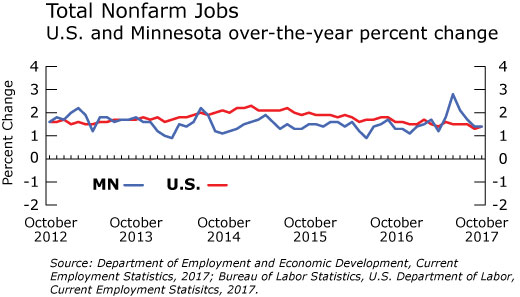by Nick Dobbins
November 2017
Monthly analysis is based on unadjusted employment data.
Employment in the Minneapolis-St Paul MSA was up by 11,063 (0.5 percent) in October. This is fairly standard growth for the month, as the metro has seen changes between 0.3 and 0.8 percent in each of the last seven Octobers. The monthly growth was led by Government, which added 6,983 jobs (2.8 percent) on the strength of 8,929 new jobs in Local Government Educational Services as the last of the new year’s hires came in for Minnesota schools. Professional and Business Services also saw notable growth, adding 5,299 jobs (1.6 percent), with 3,590 of those jobs coming in Administrative and Support and Waste Management and Remediation Services. The largest monthly decline came in Leisure and Hospitality, which was off by 5,632 (3 percent), which was actually a slightly better showing than the Supersector has had in recent Octobers. Annually metro area employment was up by 47,627 (2.4 percent). Annual growth in the area has exceeded 2 percent consistently since May, with June’s 3.2 percent over-the-year growth representing the largest proportional annual growth since prior to the recession. The metro area’s annual growth was spread across industry groups, with most Supersectors showing strong gains. Exceptions included Information (down 417 jobs or 1.1 percent) and Financial Activities (down 1,672 jobs or 1.2 percent). The largest proportional over-the-year growth came in Mining, Logging, and Construction (up 5.3 percent or 4,301 jobs), while the most actual jobs were added in Educational and Health Services (up 12,566 or 3.9 percent). Within the Supersector, all of the growth came from Health Care and Social Assistance (up 14,866 or 5.4 percent) as Educational and Health Services lost 2,300 jobs.
The Duluth-Superior MSA added 291 jobs (0.2 percent) in October. It was the second straight month with slightly slower over-the-month growth than usual for the area. Government growth of 1,267 jobs (4.8 percent) was balanced by the loss of 1,062 jobs (7.2 percent) in Leisure and Hospitality. Over the year Duluth added 2,217 jobs (1.6 percent). The only Supersectors with negative growth were Professional and Business Services (down 122 or 1.4 percent) and Information (down 29 or 2.1 percent). Mining, Logging, and Construction added 894 jobs (9 percent), and Trade, Transportation, and Utilities added 574 (2.3 percent), thanks to an increase of 572 jobs (3.7 percent) in the component Retail Trade sector.
Employment in the Rochester MSA was off slightly in October, down 168 jobs or 0.1 percent. It was the fourth straight month of over-the-month job losses for the MSA and the first October with job losses since 2011. Manufacturing employment was off by 252 (2.3 percent), while Mining, Logging, and Construction employers shed 121 jobs (2.4 percent), and Leisure and Hospitality employers lost 224 (2.1 percent). Trade, Transportation, and Utilities added 365 jobs (2.1 percent) on the strength of 284 new Retail Trade jobs. It was the strongest Supersector level growth in the MSA, both in real jobs and in proportional change. Annually Rochester employers added 641 jobs (0.5 percent). Educational and Health Services, one of the strongest Supersectors for statewide growth, actually lost jobs on an over-the-year basis, down 398 or 0.8 percent. It was the first over-the-year job loss for the Supersector in Rochester since August of 2014.
Employment in the Saint Cloud MSA was up in October as the region added 1,057 jobs (1 percent). Government (up 716 or 4.8 percent) and Educational and Health Services (up 484 or 2.1 percent) led the growth. Mining, Logging, and Construction employment was off by 188 (2.4 percent). Annually the MSA added 1,768 jobs (1.6 percent). Educational and Health Services added 1,184 jobs (5.4 percent), and Mining, Logging, and Construction added 649 (9.2 percent). The largest proportional decrease in the MSA came from the Information Supersector, which was off by 2.7 percent or 44 jobs.
The Mankato-North Mankato MSA added 1,578 jobs (2.7 percent) in October, the largest proportional growth of any MSA in the state. It was the third straight month of growth for the MSA, after a rocky start to 2017. Service Providers drove the growth, with Private Service Providing industries added 820 jobs (2.2 percent) and Government employers adding 704 (7 percent). Annually the MSA added 960 jobs (1.6 percent). The private sector added 867 of those jobs, up 1.8 percent on the year. Government employers added just 93 jobs (0.9 percent).
The Fargo-Moorhead MSA added 808 jobs (0.6 percent) in October. Supersectors followed the expected seasonal patterns, with losses in Mining, Logging, and Construction (down 122 or 1.2 percent) and Leisure and Hospitality (down 241 or 1.7 percent), while Government employers added 559 jobs (3 percent), largely from within Local Government. Annually the MSA added 2,551 jobs (1.8 percent). The biggest growth, both in proportional and whole-number terms, came from Professional and Business Services, which added 1,123 jobs (7.1 percent). Trade, Transportation, and Utilities lost 299 jobs (1 percent).
The Grand Forks-East Grand Forks MSA added 271 jobs (0.5 percent) in October. Government employers added 256 (1.8 percent). Annually the area lost 1,628 jobs (2.7 percent). It remained the only MSA in Minnesota to lose jobs on the year. Mining, Logging, and Construction continued to weigh the over-the-year growth down, losing 1,179 jobs (24.7 percent) since October of 2016.
